Search Result
Results for "
pyrimidine derivative
" in MedChemExpress (MCE) Product Catalog:
15
Isotope-Labeled Compounds
| Cat. No. |
Product Name |
Target |
Research Areas |
Chemical Structure |
-
- HY-I0960
-
Uracil
3 Publications Verification
|
Endogenous Metabolite
|
Cancer
|
|
Uracil is a common and naturally occurring pyrimidine derivative and one of the four nucleobases in the nucleic acid of RNA.
|
-
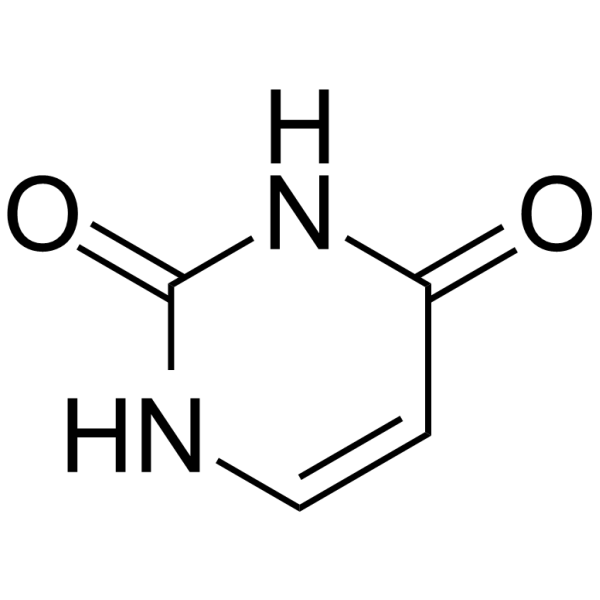
-
- HY-W027595
-
|
|
Others
|
Others
|
|
N-Benzyl-6-chloropyrimidin-4-amine is a pyrimidine derivative .
|
-
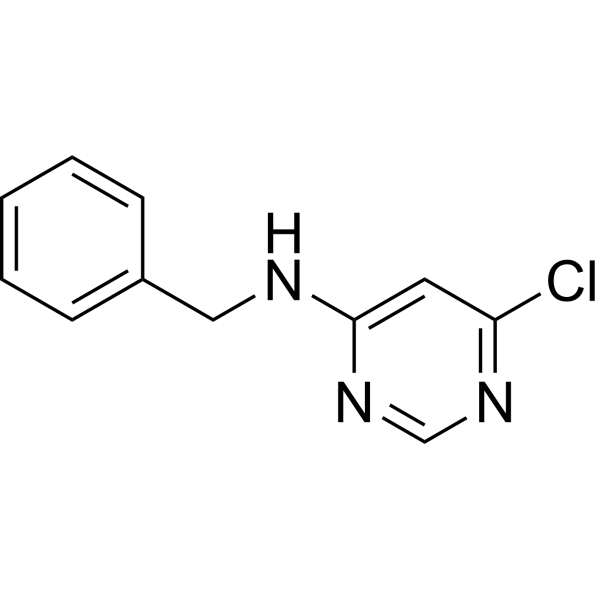
-
- HY-Y1298
-
|
Acetoacetate methyl ester; Methyl 3-oxobutanoate; Methyl acetoacetate
|
Endogenous Metabolite
|
Metabolic Disease
|
|
Methyl acetylacetate is a chemical reagent used in the synthesis of pharmaceuticals for the synthesis of α-substituted acetoacetate and cyclic compounds such as pyrazole, pyrimidine, and coumarin derivatives .
|
-

-
- HY-151938
-
|
|
HIV
|
Infection
|
|
Reverse transcriptase-IN-3 is a pyrimidine-5-carboxamide derivative, acts as an inhibitor of HIV-1. Reverse transcriptase-IN-3 shows potent activity against the HIV-1 wild-type and mutant strains .
|
-
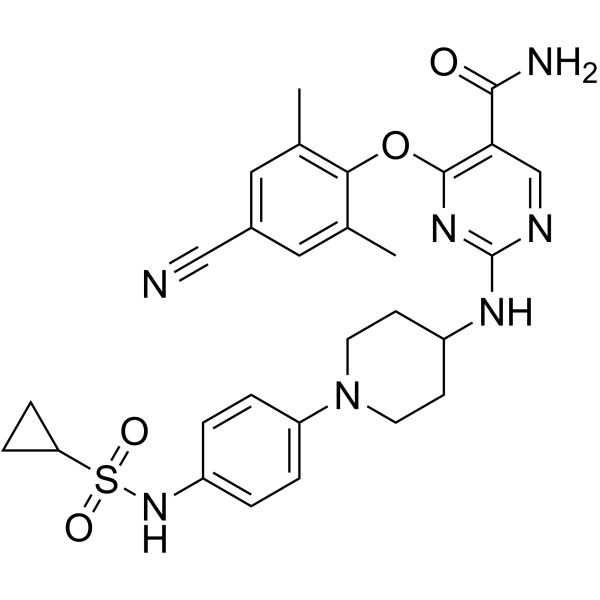
-
- HY-157578
-
-
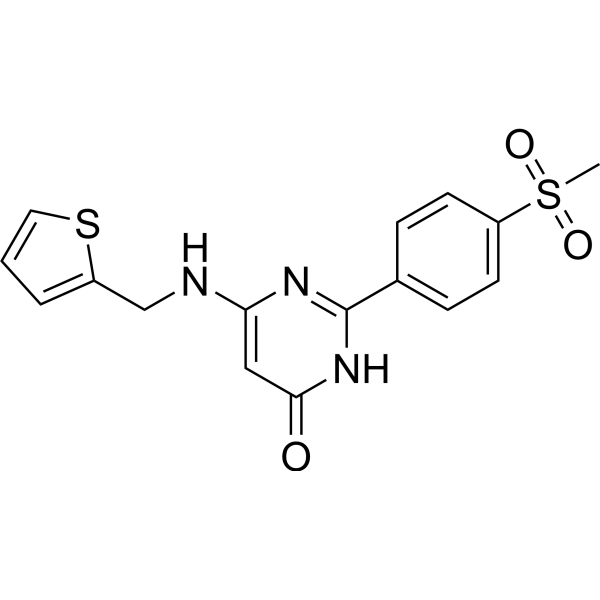
-
- HY-157583
-
|
|
COX
|
Others
|
|
COX-2-IN-39 (compound 44) is a potent inhibitor of COX-2, with the IC50 value of 0.4 nM .
|
-

-
- HY-I0960R
-
|
|
Endogenous Metabolite
|
Cancer
|
|
Uracil (Standard) is the analytical standard of Uracil. This product is intended for research and analytical applications. Uracil is a common and naturally occurring pyrimidine derivative and one of the four nucleobases in the nucleic acid of RNA.
|
-
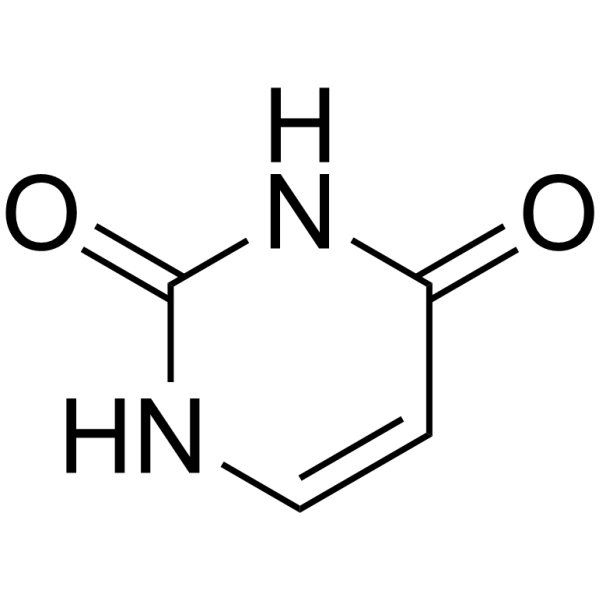
-
- HY-I0960S2
-
|
|
Endogenous Metabolite
|
Cancer
|
|
Uracil- 13C is the 13C labeled Uracil[1]. Uracil is a common and naturally occurring pyrimidine derivative and one of the four nucleobases in the nucleic acid of RNA[2].
|
-

-
- HY-I0960S4
-
|
|
Endogenous Metabolite
|
Cancer
|
|
Uracil-d2 is the deuterium labeled Uracil[1]. Uracil is a common and naturally occurring pyrimidine derivative and one of the four nucleobases in the nucleic acid of RNA[2].
|
-
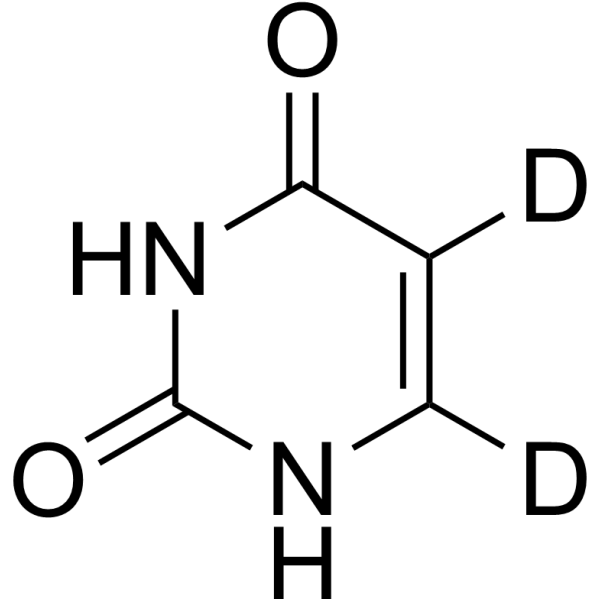
-
- HY-I0960S7
-
|
|
Endogenous Metabolite
|
Cancer
|
|
Uracil-d1 is the deuterium labeled Uracil[1]. Uracil is a common and naturally occurring pyrimidine derivative and one of the four nucleobases in the nucleic acid of RNA[2].
|
-
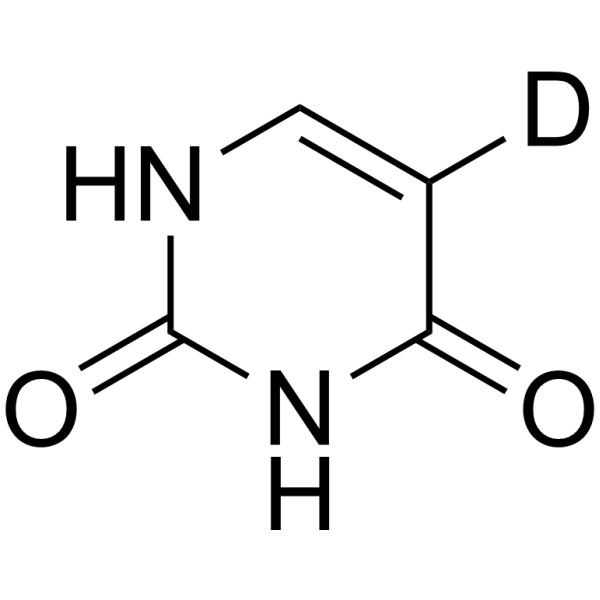
-
- HY-I0960S9
-
|
|
Endogenous Metabolite
|
Cancer
|
|
Uracil-d4 is the deuterium labeled Uracil[1]. Uracil is a common and naturally occurring pyrimidine derivative and one of the four nucleobases in the nucleic acid of RNA[2].
|
-
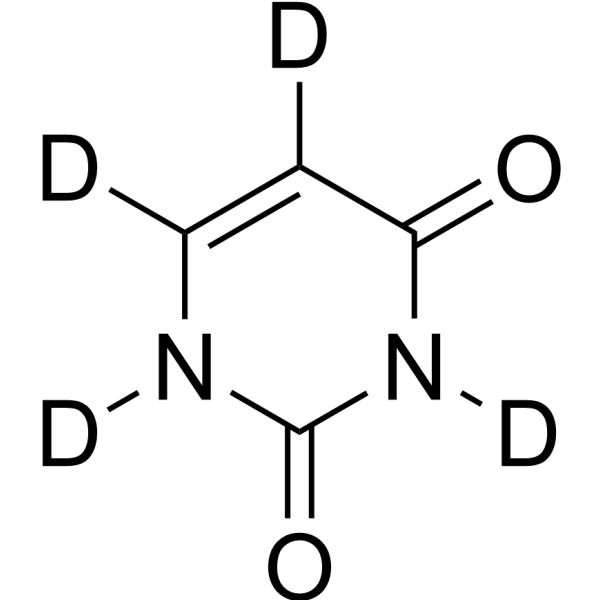
-
- HY-I0960S1
-
|
|
Endogenous Metabolite
|
Cancer
|
|
Uracil- 13C4 is the 13C labeled Uracil[1]. Uracil is a common and naturally occurring pyrimidine derivative and one of the four nucleobases in the nucleic acid of RNA[2].
|
-

-
- HY-I0960S5
-
|
|
Endogenous Metabolite
|
Cancer
|
|
Uracil- 15N2 is the 15N labeled Uracil[1]. Uracil is a common and naturally occurring pyrimidine derivative and one of the four nucleobases in the nucleic acid of RNA[2].
|
-
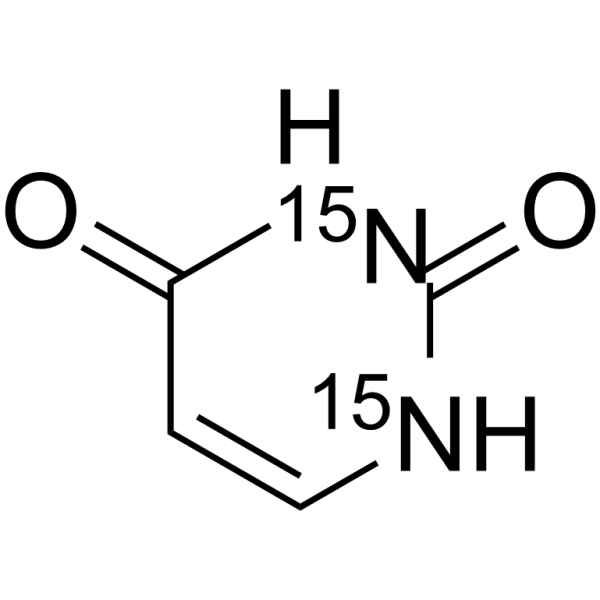
-
- HY-I0960S6
-
|
|
Endogenous Metabolite
|
Cancer
|
|
Uracil-d2-1 is the deuterium labeled Uracil[1]. Uracil is a common and naturally occurring pyrimidine derivative and one of the four nucleobases in the nucleic acid of RNA[2].
|
-
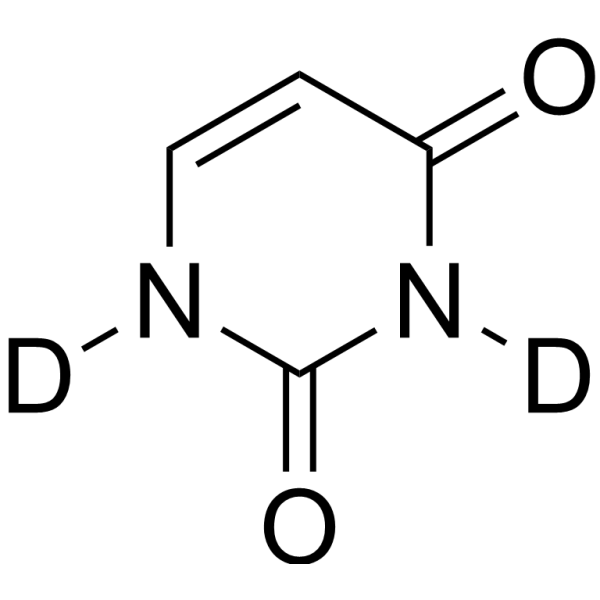
-
- HY-I0960S8
-
|
|
Endogenous Metabolite
|
Cancer
|
|
Uracil-d1-1 is the deuterium labeled Uracil[1]. Uracil is a common and naturally occurring pyrimidine derivative and one of the four nucleobases in the nucleic acid of RNA[2].
|
-
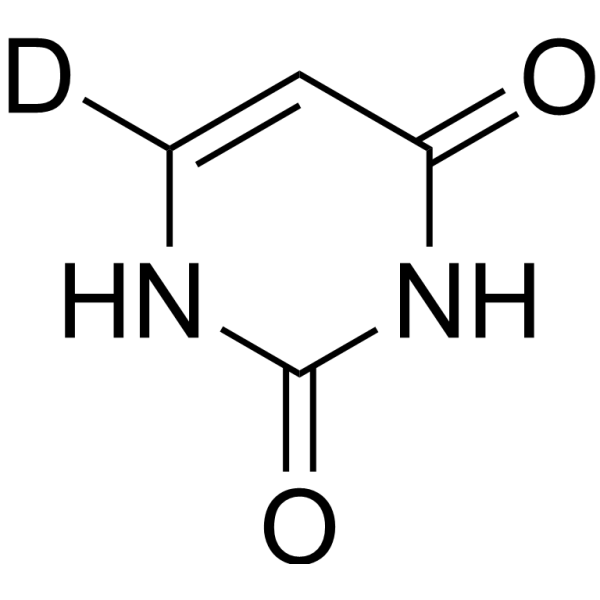
-
- HY-I0960S
-
|
|
Endogenous Metabolite
|
Cancer
|
|
Uracil- 13C2, 15N2 is the 13C-labeled and 15N-labeled Uracil. Uracil is a common and naturally occurring pyrimidine derivative and one of the four nucleobases in the nucleic acid of RNA.
|
-
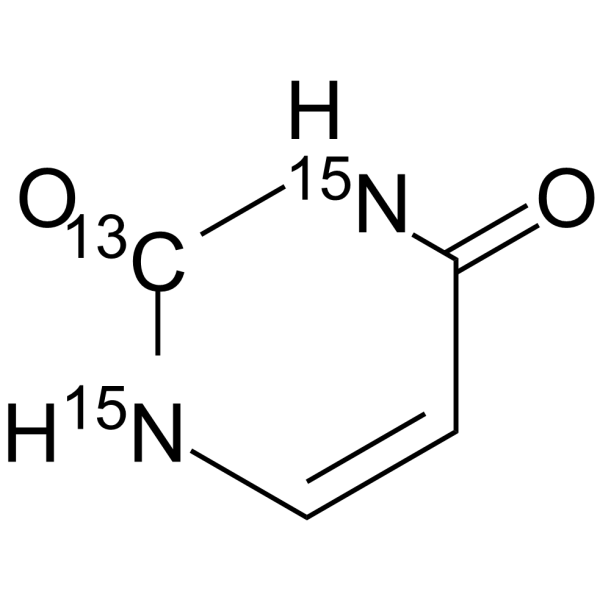
-
- HY-139974
-
|
|
Cholinesterase (ChE)
|
Neurological Disease
|
|
BChE-IN-2 (compound 22) is a potent inhibitor of BChE with a Ki of 0.099 μM. BChE-IN-2 is a pyrimidine and pyridine derivative. BChE-IN-2 has the potential for the research of Alzheimer’s disease (AD) .
|
-

-
- HY-I0960S3
-
|
|
Endogenous Metabolite
|
Cancer
|
|
Uracil- 13C4, 15N2 is the 13C and 15N labeled Uracil[1]. Uracil is a common and naturally occurring pyrimidine derivative and one of the four nucleobases in the nucleic acid of RNA[2].
|
-
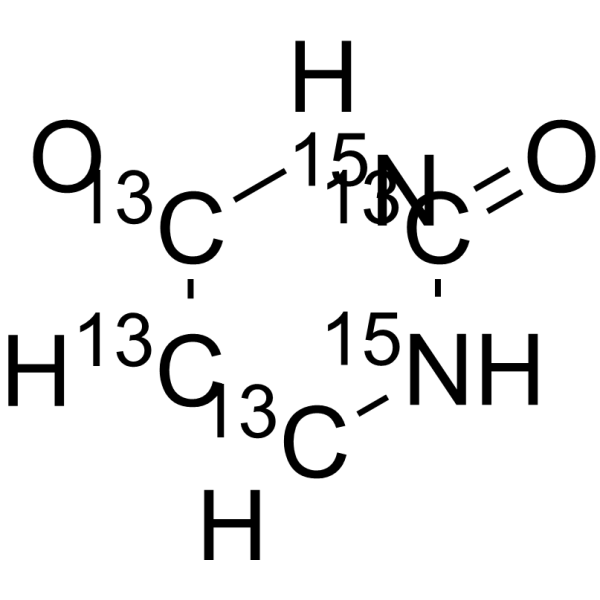
-
- HY-155761
-
|
|
Fungal
|
Infection
|
|
Antifungal agent 71 (compound 6r) is a trifluoromethyl pyrimidine derivative with antifungal activity. Antifungal agent 71 exhibits good in vitro antifungal activity against F. oxysporum, with the EC50 value of 3.61 μg/mL .
|
-
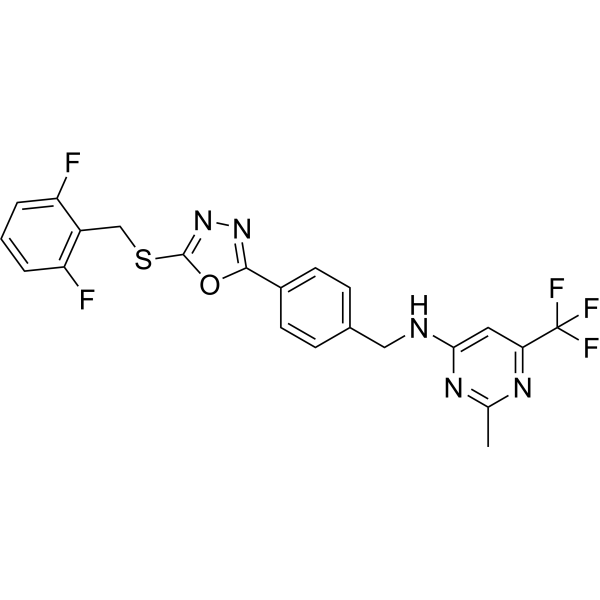
-
- HY-Y1055
-
Guanine
3 Publications Verification
|
DNA/RNA Synthesis
Endogenous Metabolite
|
Cancer
|
|
Guanine is one of the fundamental components of nucleic acids (DNA and RNA). Guanine is a purine derivative, consisting of a fused pyrimidine-imidazole ring system with conjugated double bonds. Guanine has the potential to serve as a large-capacity N pool .
|
-
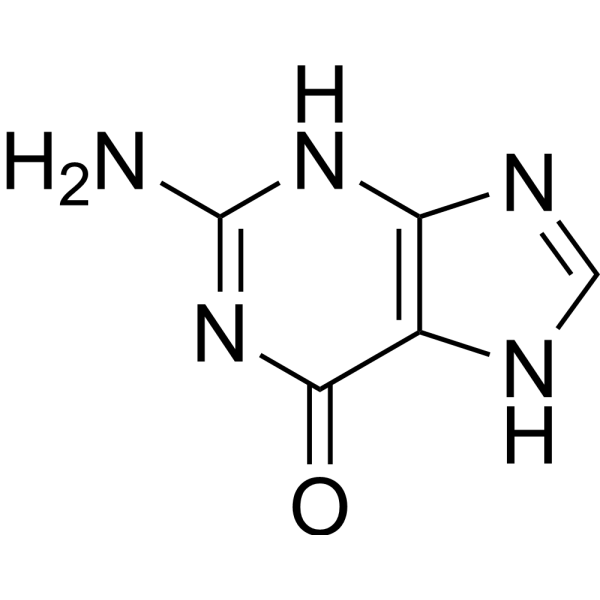
-
- HY-148832
-
|
|
Btk
|
Inflammation/Immunology
Cancer
|
|
BTK-IN-20 (compound 283) is a BTK tyrosine kinase inhibitor and a 1H-pyrazolo[3,4-d]pyrimidine derivative. BTK-IN-20 can be used for the research of cancer and inflammation .
|
-

-
- HY-145554
-
|
|
Others
|
Others
|
|
Bafrekalant is a diazabicyclic substituted imidazo[l,2-a]pyrimidine-derivative. Bafrekalant has the potential for the research of breathing disorders, including sleep-related breathing disorders such as obstructive and central sleep apnea and snoring (extracted from patent WO2018228907A1).
|
-

-
- HY-15645
-
-

-
- HY-Y1298R
-
|
Acetoacetate methyl ester (Standard); Methyl 3-oxobutanoate (Standard); Methyl acetoacetate (Standard)
|
Endogenous Metabolite
|
Metabolic Disease
|
|
Methyl acetylacetate (Standard) is the analytical standard of Methyl acetylacetate. This product is intended for research and analytical applications. Methyl acetylacetate is a chemical reagent used in the synthesis of pharmaceuticals for the synthesis of α-substituted acetoacetate and cyclic compounds such as pyrazole, pyrimidine, and coumarin derivatives .
|
-
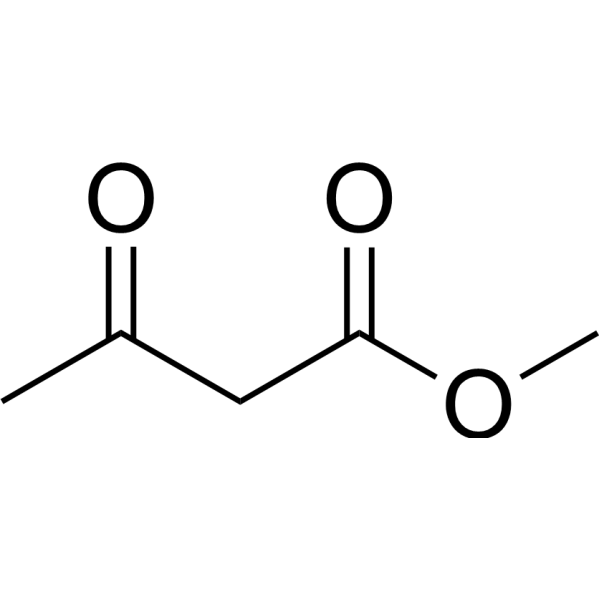
-
- HY-W049802
-
|
|
Complement System
|
Inflammation/Immunology
|
|
N-((Allyloxy)carbonyl)-N-methyl-L-alanine is a Alanine derivative. N-((Allyloxy)carbonyl)-N-methyl-L-alanine can be used for the synthesis of inhibitors of complement factor D. Complement factor D inhibitors can be used in the research of immune system related disease .
|
-
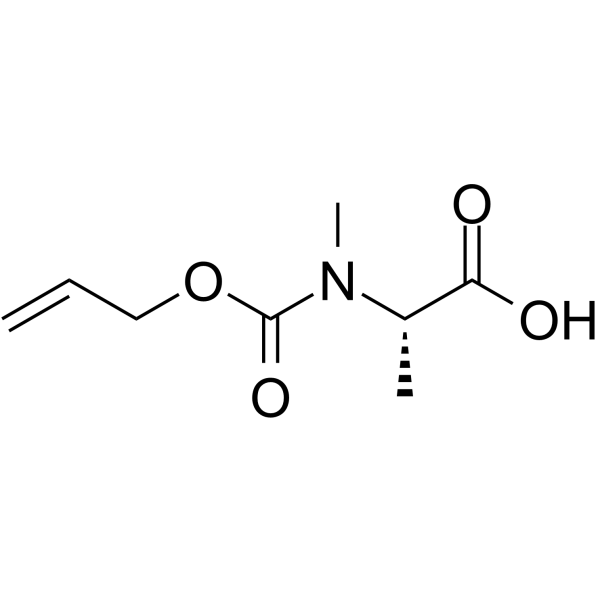
-
- HY-Y1055S
-
|
|
DNA/RNA Synthesis
Endogenous Metabolite
|
Cancer
|
|
Guanine- 13C is the 13C labeled Guanine[1]. Guanine (2-Aminohypoxanthine) is one of the fundamental components of nucleic acids (DNA and RNA). Guanine is a purine derivative, consisting of a fused pyrimidine-imidazole ring system with conjugated double bonds.
|
-
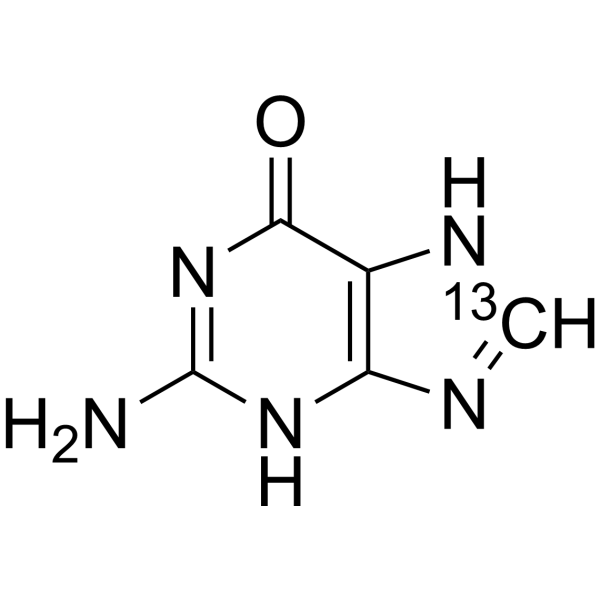
-
- HY-16398
-
|
|
DNA Alkylator/Crosslinker
|
Cancer
|
|
Pipobroman is a bromide derivative of piperazine and acts as an alkylating agent. Pipobroman plays its role by inhibiting DNA and RNA polymerase or by reducing pyrimidine nucleotide incorporation into DNA. Pipobroman can be used for the cancer research, including polycythemia vera, myeloproliferative neoplasm, and AML et.al .
|
-

-
- HY-134772
-
|
|
STAT
Cytochrome P450
|
Inflammation/Immunology
|
|
AS1810722 is an orally active and potent STAT6 inhibitor with an IC50 of 1.9 nM. AS1810722 shows a good profile of CYP3A4 inhibition. AS1810722, a derivative of fused bicyclic pyrimidine, has the potential for allergic diseases such as asthma and atopic diseases research .
|
-
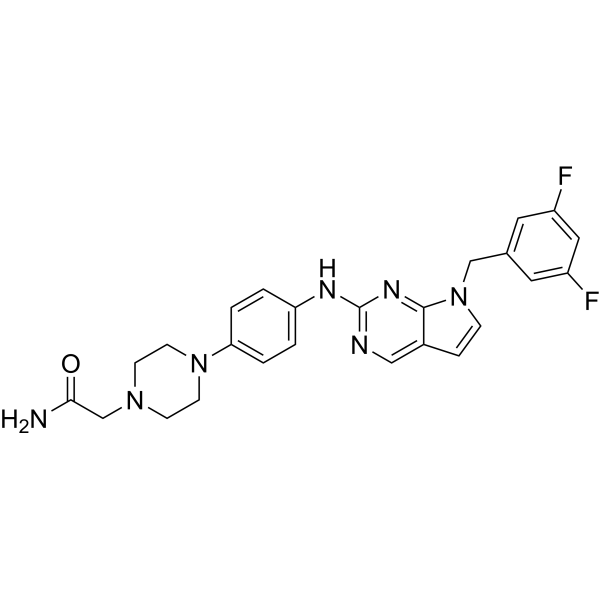
-
- HY-Y1055S3
-
-
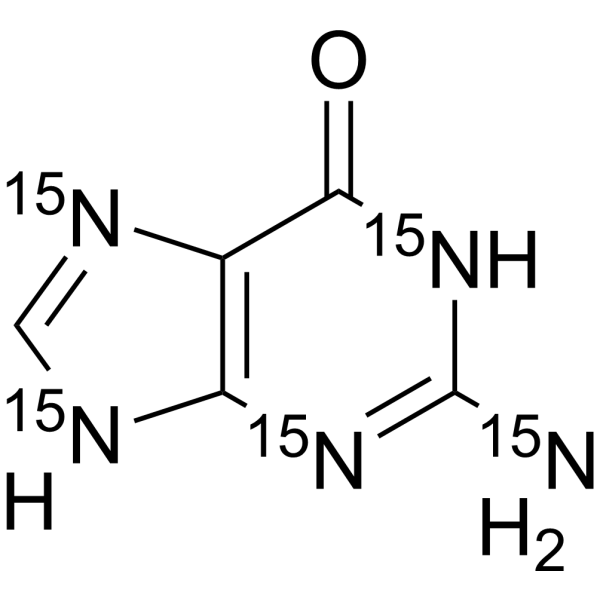
-
- HY-149365
-
|
|
Salt-inducible Kinase (SIK)
|
Inflammation/Immunology
|
|
SIKs-IN-1 (compound 8h), a pyrimidine-5-carboxamide derivative, is a Salt-inducible kinases (SIKs) inhibitor. SIKs regulates the transformation of M1/M2 macrophages, involving in inflammation process. SIKs-IN-1 inhibits SIK activity, up-regulates anti-inflammatory cytokine IL-10, but down-regulates pro-inflammatory cytokine IL-12. SIKs-IN-1 shows excellent anti-inflammatory effects in a DSS-induced colitis model .
|
-
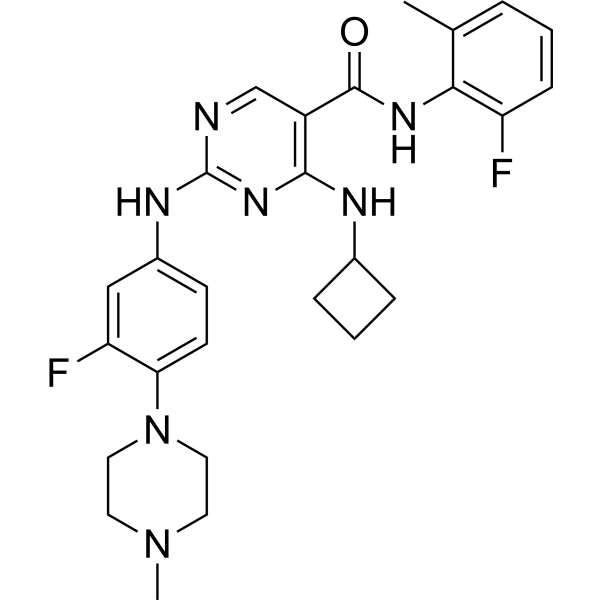
-
- HY-126297
-
|
|
c-Fms
|
Inflammation/Immunology
Cancer
|
|
c-Fms-IN-10 is the derivative of thieno [3,2-d] pyrimidine, an kinase inhibitor of FMS (Colony stimulating factor-1 receptor, CSF-1R) with IC50 of 2 nM.
c-Fms-IN-10 has anti-tumor activity .
|
-
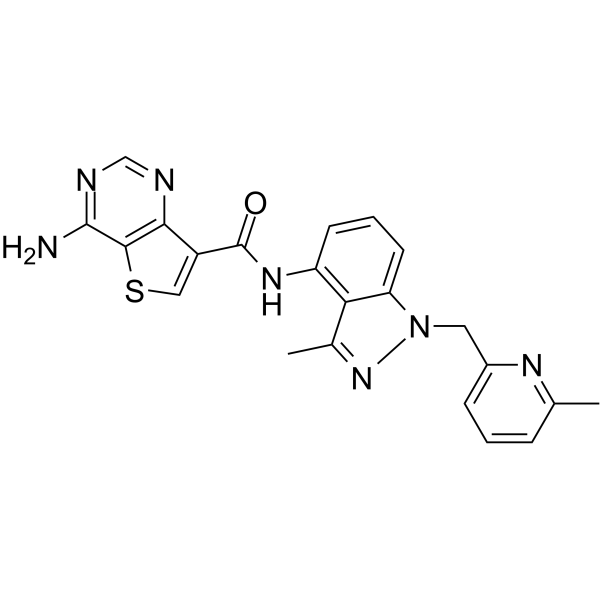
-
- HY-Y1055S4
-
-
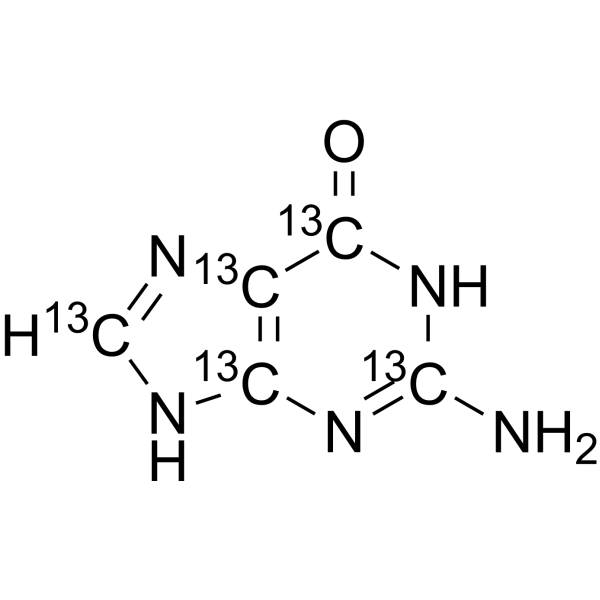
-
- HY-130070
-
|
|
Potassium Channel
|
Neurological Disease
|
|
QO-40 is a pyrazolo[1,5-a]pyrimidine-7(4H)-one (PPO) derivative and an activator of the voltage-gated M-type potassium channel KCNQ encoded by the KCNQ2/3 gene (EC50: 1.25 μM) .
|
-

-
- HY-Y1055S1
-
|
|
DNA/RNA Synthesis
Endogenous Metabolite
|
Cancer
|
|
Guanine- 13C, 15N2 is the 13C and 15N labeled Guanine[1]. Guanine (2-Aminohypoxanthine) is one of the fundamental components of nucleic acids (DNA and RNA). Guanine is a purine derivative, consisting of a fused pyrimidine-imidazole ring system with conjugated double bonds.
|
-
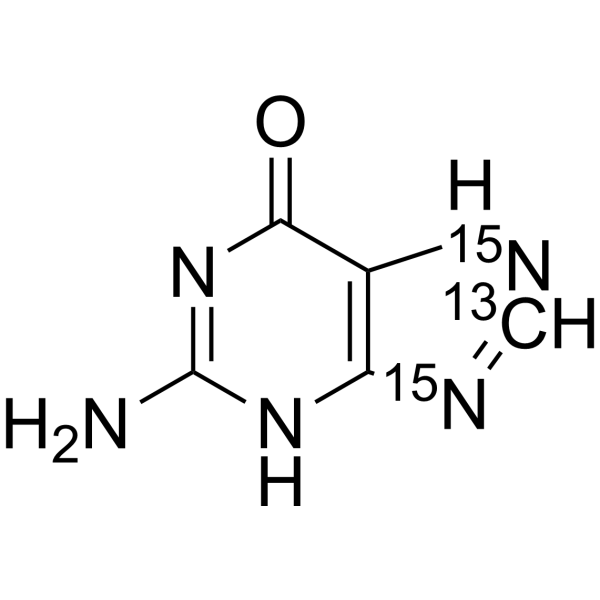
-
- HY-Y1055S2
-
|
|
Isotope-Labeled Compounds
DNA/RNA Synthesis
Endogenous Metabolite
|
Cancer
|
|
Guanine- 13C5, 15N5 is 13C and 15N-labeled Guanine (HY-Y1055). Guanine (2-Aminohypoxanthine) is one of the fundamental components of nucleic acids (DNA and RNA). Guanine is a purine derivative, consisting of a fused pyrimidine-imidazole ring system with conjugated double bonds.
|
-
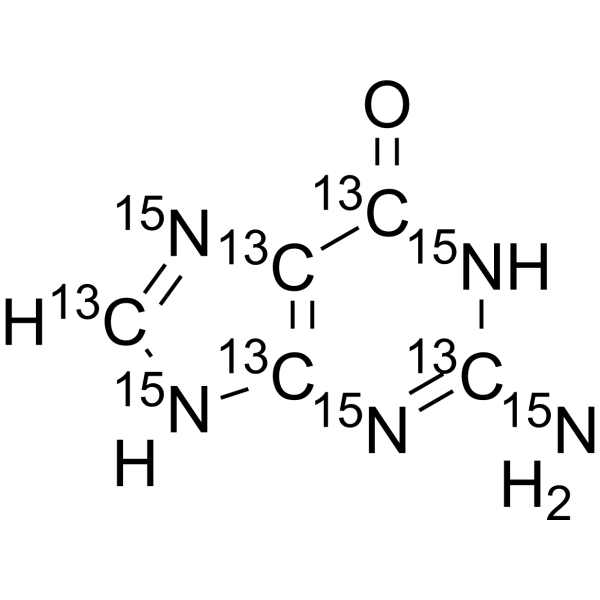
-
- HY-16182A
-
|
|
Biochemical Assay Reagents
|
Others
|
|
Ecamsule disodium is a broad-spectrum UVA filter that can be used in sunscreen product. Ecamsule reduces biological damage caused by solar radiation such as pyrimidine dimer formation, p53 protein accumula-tion, or collagenase 2 expression .
|
-
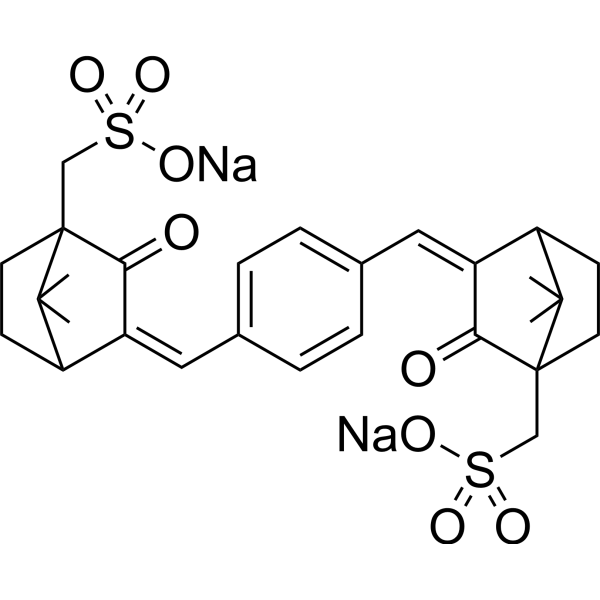
-
- HY-16182
-
|
|
Biochemical Assay Reagents
|
Others
|
|
Ecamsule is a broad-spectrum UVA filter that can be used in sunscreen product. Ecamsule reduces biological damage caused by solar radiation such as pyrimidine dimer formation, p53 protein accumula-tion, or collagenase 2 expression. Ecamsule has the potential for the research of polymorphous light eruption (PMLE) .
|
-
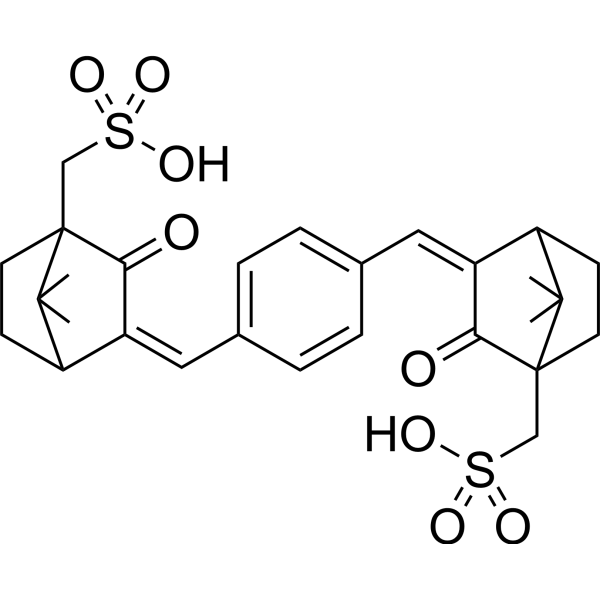
-
- HY-124719
-
|
|
PI3K
mTOR
GSK-3
CDK
|
Cancer
|
|
hSMG-1 inhibitor 11j, a pyrimidine derivative, is a potent and selective inhibitor of hSMG-1, with an IC50 of 0.11 nM. hSMG-1 inhibitor 11j exhibits >455-fold selectivity for hSMG-1 over mTOR (IC50=50 nM), PI3Kα/γ (IC50=92/60 nM) and CDK1/CDK2 (IC50=32/7.1 μM). hSMG-1 inhibitor 11j can be used for the research of cancer .
|
-

-
- HY-161269
-
|
|
EGFR
|
Cancer
|
|
EGFR-IN-101 (I-10) is a 2-phenylamino pyrimidine derivative. EGFR-IN-101 is a EGFR inhibitor. The IC50 values for EGFR L858R/T790M/C797S and Ba/F3-EGFR L858R/T790M/C797S are 33.26 and 106.4 nM, respectively. EGFR-IN-101 can be used IN the study of non-small cell lung cancer (NSCLC) .
|
-
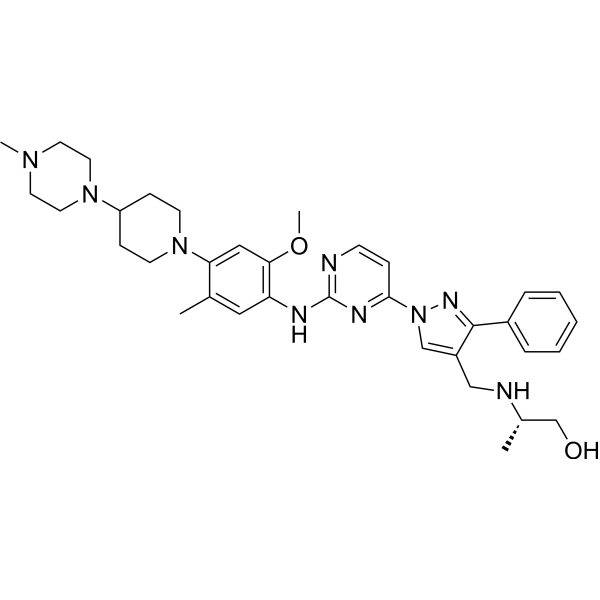
-
- HY-147681
-
|
|
FGFR
|
Neurological Disease
|
|
SUN13837 is an orally active, potent and BBB-penetrated FGFR (fibroblast growth factor receptor) modulator. SUN13837 shows neuroprotective activity. SUN13837 can be used for neurodegenerative diseases research .
|
-
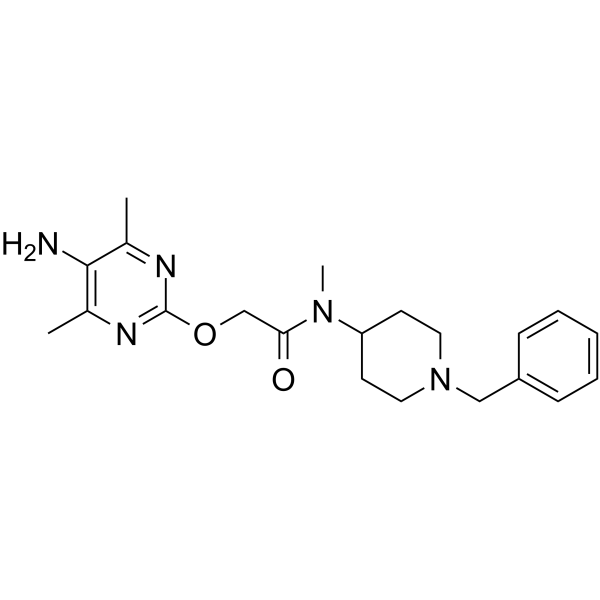
-
- HY-147683
-
|
|
FGFR
|
Neurological Disease
|
|
FGFR-IN-3 (compound 6) is an orally active, potent and BBB-penetrated FGFR (fibroblast growth factor receptor) modulator. FGFR-IN-3 shows neuroprotective activity. FGFR-IN-3 can be used for neurodegenerative diseases research .
|
-
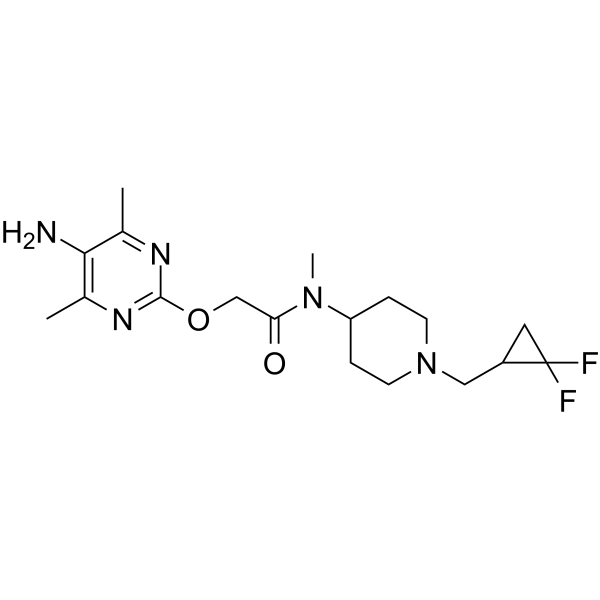
-
- HY-147684
-
|
|
FGFR
|
Neurological Disease
|
|
FGFR-IN-7 (compound 17) is an orally active, potent and BBB-penetrated FGFR (fibroblast growth factor receptor) modulator. FGFR-IN-7 shows neuroprotective activity. FGFR-IN-7 improves brain exposure and reduced risk of phospholidosis. FGFR-IN-7 can be used for neurodegenerative diseases research .
|
-
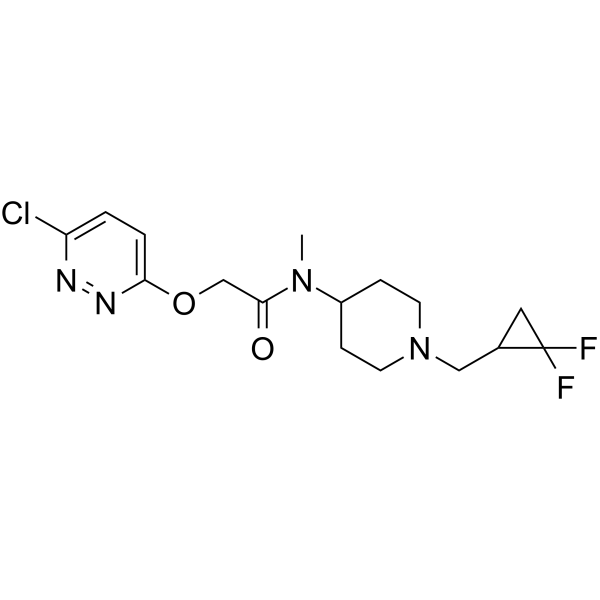
| Cat. No. |
Product Name |
Target |
Research Area |
-
- HY-W049802
-
|
|
Complement System
|
Inflammation/Immunology
|
|
N-((Allyloxy)carbonyl)-N-methyl-L-alanine is a Alanine derivative. N-((Allyloxy)carbonyl)-N-methyl-L-alanine can be used for the synthesis of inhibitors of complement factor D. Complement factor D inhibitors can be used in the research of immune system related disease .
|
| Cat. No. |
Product Name |
Category |
Target |
Chemical Structure |
| Cat. No. |
Product Name |
Chemical Structure |
-
- HY-I0960S4
-
|
|
|
Uracil-d2 is the deuterium labeled Uracil[1]. Uracil is a common and naturally occurring pyrimidine derivative and one of the four nucleobases in the nucleic acid of RNA[2].
|
-

-
- HY-I0960S9
-
|
|
|
Uracil-d4 is the deuterium labeled Uracil[1]. Uracil is a common and naturally occurring pyrimidine derivative and one of the four nucleobases in the nucleic acid of RNA[2].
|
-

-
- HY-I0960S2
-
|
|
|
Uracil- 13C is the 13C labeled Uracil[1]. Uracil is a common and naturally occurring pyrimidine derivative and one of the four nucleobases in the nucleic acid of RNA[2].
|
-

-
- HY-I0960S7
-
|
|
|
Uracil-d1 is the deuterium labeled Uracil[1]. Uracil is a common and naturally occurring pyrimidine derivative and one of the four nucleobases in the nucleic acid of RNA[2].
|
-

-
- HY-I0960S1
-
|
|
|
Uracil- 13C4 is the 13C labeled Uracil[1]. Uracil is a common and naturally occurring pyrimidine derivative and one of the four nucleobases in the nucleic acid of RNA[2].
|
-

-
- HY-I0960S5
-
|
|
|
Uracil- 15N2 is the 15N labeled Uracil[1]. Uracil is a common and naturally occurring pyrimidine derivative and one of the four nucleobases in the nucleic acid of RNA[2].
|
-

-
- HY-I0960S6
-
|
|
|
Uracil-d2-1 is the deuterium labeled Uracil[1]. Uracil is a common and naturally occurring pyrimidine derivative and one of the four nucleobases in the nucleic acid of RNA[2].
|
-

-
- HY-I0960S8
-
|
|
|
Uracil-d1-1 is the deuterium labeled Uracil[1]. Uracil is a common and naturally occurring pyrimidine derivative and one of the four nucleobases in the nucleic acid of RNA[2].
|
-

-
- HY-I0960S
-
|
|
|
Uracil- 13C2, 15N2 is the 13C-labeled and 15N-labeled Uracil. Uracil is a common and naturally occurring pyrimidine derivative and one of the four nucleobases in the nucleic acid of RNA.
|
-

-
- HY-I0960S3
-
|
|
|
Uracil- 13C4, 15N2 is the 13C and 15N labeled Uracil[1]. Uracil is a common and naturally occurring pyrimidine derivative and one of the four nucleobases in the nucleic acid of RNA[2].
|
-

-
- HY-Y1055S
-
|
|
|
Guanine- 13C is the 13C labeled Guanine[1]. Guanine (2-Aminohypoxanthine) is one of the fundamental components of nucleic acids (DNA and RNA). Guanine is a purine derivative, consisting of a fused pyrimidine-imidazole ring system with conjugated double bonds.
|
-

-
- HY-Y1055S3
-
|
|
|
Guanine- 15N5 is 15N labeled Guanine (HY-Y1055). Guanine (2-Aminohypoxanthine) is one of the fundamental components of nucleic acids (DNA and RNA). Guanine is a purine derivative, consisting of a fused pyrimidine-imidazole ring system with conjugated double bonds.
|
-

-
- HY-Y1055S4
-
|
|
|
Guanine- 13C5 is 13C-labeled Guanine (HY-Y1055). Guanine (2-Aminohypoxanthine) is one of the fundamental components of nucleic acids (DNA and RNA). Guanine is a purine derivative, consisting of a fused pyrimidine-imidazole ring system with conjugated double bonds.
|
-

-
- HY-Y1055S1
-
|
|
|
Guanine- 13C, 15N2 is the 13C and 15N labeled Guanine[1]. Guanine (2-Aminohypoxanthine) is one of the fundamental components of nucleic acids (DNA and RNA). Guanine is a purine derivative, consisting of a fused pyrimidine-imidazole ring system with conjugated double bonds.
|
-

-
- HY-Y1055S2
-
|
|
|
Guanine- 13C5, 15N5 is 13C and 15N-labeled Guanine (HY-Y1055). Guanine (2-Aminohypoxanthine) is one of the fundamental components of nucleic acids (DNA and RNA). Guanine is a purine derivative, consisting of a fused pyrimidine-imidazole ring system with conjugated double bonds.
|
-

Your information is safe with us. * Required Fields.
Inquiry Information
- Product Name:
- Cat. No.:
- Quantity:
- MCE Japan Authorized Agent:


















































